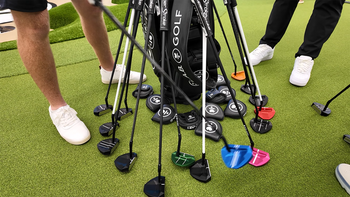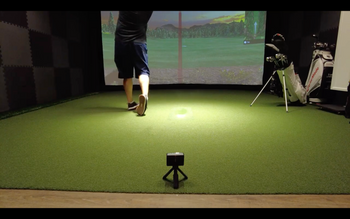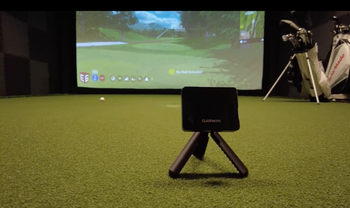You know that feeling when you're shopping for a golf launch monitor and realize you'll be paying subscription fees forever? Yeah, the GC3 from Foresight Sports doesn't play that game. You pay once, and you're done - no monthly charges eating into your beer money.
Here's what makes this thing special: Most launch monitors need you to set them up behind the ball, which means you'd better have a garage the size of a barn. The GC3? It sits beside your ball instead. So if you've got a normal-sized room and not some massive warehouse, you're golden.
Marc, who tests golf gear for us here at Golfers Authority, spent time with this unit and came away impressed. The GC3 sits right at the top tier of home simulator options, and once you understand why, it makes total sense.
Picture this - you're setting up your home simulator and calculating costs. With most monitors, you're doing mental gymnastics trying to figure out yearly fees on top of the initial price. It's like buying a car and then discovering you need to pay rent on it too. The GC3 cuts through that nonsense with straightforward pricing.
Now let's talk about your actual golf room. You've probably measured your space and gotten depressed looking at other monitors' requirements. Since the GC3 parks itself next to where you're hitting instead of way behind you, you can actually use that spare bedroom or basement corner. You don't need Tour-level practice facility dimensions.
The real question is whether this setup matches what you need. If you're tired of subscription headaches and working with limited space, this monitor checks both boxes without compromise.
Table of Contents
Key Features
Compact Room Dimensions: The GC3 works efficiently in relatively small spaces, with recommended minimums of 10 feet wide, 10 feet deep, and 9 feet tall, making it ideal for home use where space is limited.
Space-Saving Camera-Based Technology: Unlike radar-based launch monitors that require significant room depth, the GC3 uses three precision cameras positioned beside the ball, drastically reducing the need for long room lengths.
Flexible Ceiling Height Adaptability: While 9 feet is recommended, shorter golfers may require less ceiling height, and taller golfers or those with longer swings may need more, but most home environments can accommodate this range.
Foresight GC3 with LINK Golf Launch Monitor & Simulator
Transform your home into a luxury golf haven with the Foresight GC3 - but proper space planning ensures maximum performance & investment value.
Optimal Room Dimensions for Setting Up Your Foresight Sports GC3 Golf Simulator
You're gonna love how much space the Foresight GC3 saves compared to those massive radar units. Think about it - you only need about 10 feet from front to back, while those Doppler systems eat up 21 feet of your basement or garage. That's like the difference between parking a golf cart and a stretch limo in there.
For the sweet spot, you're looking at a room that's 10 feet by 10 feet with 9-foot ceilings. Though if you've got the space, bumping up to 12 feet deep gives you that extra breathing room when you're really letting it rip with the driver.
Here's the deal with ceiling height - if you're swinging like John Daly, those 9-foot ceilings might make you nervous. Taller players with those long, flowing swings probably want another foot or two of clearance. Nobody wants to explain ceiling divots to their spouse, right? Meanwhile, if you're more compact like me, standard height works just fine.
Width-wise, 10 feet is your bare minimum. Planning on going all-out with a full simulator setup? You'll want 12 or 13 feet to accommodate those bigger impact screens and enclosures. Trust me, cramped golf isn't fun golf.
Now, here's something the guys at Golfers Authority pointed out - their SimStudio packages include a 5-foot by 5-foot hitting mat. Depending on your stance, squeezing both your feet and the GC3 onto that mat can get tight. Smart fix, though - just prop the unit up on a piece of turf or even a thick book beside the mat. Keeps everything level and gives you room to plant your feet properly.
The camera-based design of the GC3 (along with similar units like the Bushnell Launch Pro and SkyTrak+) definitely beats radar for tight spaces. Just remember, there might be some trade-offs to consider when you're working with minimal square footage.

Trade-Offs of Compact Design – What to Consider with the Foresight Sports GC3
You know how some launch monitors need tons of space behind where you're hitting? Well, camera-based units like the Foresight Sports GC3 fix that problem by sitting next to your ball instead. Pretty sweet when you're cramming a simulator into your garage, right?
But here's where it gets tricky if you've got both righties and lefties in your foursome. Those radar-style monitors - think FlightScope Mevo Plus, Rapsodo MLM2PRO, or Garmin Approach R10 - park themselves about 6 to 8 feet behind your hitting area. Since they're reading the ball from behind, you and your southpaw buddy can take turns without touching anything.
The GC3? Different story. Since it's camping out beside your ball, you'll need to physically pick it up and relocate it to the other side every time you switch between right and left-handed players. Imagine doing that mid-round when you're trying to keep pace on a virtual Pebble Beach - totally kills the vibe.
If you're setting up a home simulator and regularly have mixed groups over for golf nights, this back-and-forth shuffle could get old fast. Nothing worse than breaking up the flow when everyone's having a good time and the bets are getting interesting. So while the GC3's space-saving design is clutch for tight spaces, you'll want to think twice if your regular crew includes players swinging from both sides of the ball.
Foresight GC3 with LINK Golf Launch Monitor & Simulator
Transform your home into a luxury golf haven with the Foresight GC3 - but proper space planning ensures maximum performance & investment value.
Is the Foresight GC3 with LINK Golf Launch Monitor & Simulator Worth It?
Absolutely, while the Foresight GC3 with LINK Golf Launch Monitor & Simulator
It is a great product, there are a few pros and cons that you need to be aware of:
Pros:
No Ongoing Subscription Fees: Unlike many competing launch monitors, the GC3 does not require a recurring subscription to access its core features or software, offering a straightforward, one-time purchase that is especially attractive for those seeking a long-term, premium solution.
Smaller Space Requirements Reduce Construction or Renovation Costs: The GC3’s camera-based system allows it to operate in much smaller rooms (minimum 10’ wide x 10’ deep x 9’ high) compared to radar-based monitors, which often require deeper spaces (up to 21 feet). This can significantly reduce the need for expensive home modifications or dedicated room builds.
Premium Software and Simulation Experience Included: The GC3 comes bundled with advanced simulation software (like FSX Play and FSX 2020), providing a high-end, immersive golfing experience without additional software purchase costs, which are common with other systems.
Cons:
Higher Upfront Cost: The GC3 has a premium price tag (starting at $5,999 for ball data only, up to $8,499 for full club and ball data with extra courses), which may be prohibitive for casual users or those on a budget.
Potential Need for Larger or Customized Enclosures for Multi-User or Left/Right-Handed Play: While the GC3 saves space for single users, frequent switching between right- and left-handed players requires repositioning the device, which may prompt investment in a more flexible (and costly) room setup or enclosure to accommodate both users comfortably.
Limited Room for Expansion or Comfortable Multi-User Experiences: The minimum space requirements, while smaller than radar-based systems, may still restrict comfort or prevent the addition of premium features like extra seating, lounge areas, or larger screens unless you invest in a room that is significantly larger than the minimum recommendations.
Frequently Asked Questions
What are the minimum room dimensions needed for a Foresight Sports GC3 home golf simulator?
The recommended minimum space is 10 feet wide, 10 feet deep, and 9 feet high. This allows for comfortable swinging and proper placement of the simulator components.
Is more space better for the GC3 simulator, and what are the optimal dimensions?
Yes, having more space enhances comfort and performance. Optimal dimensions are around 12 feet deep and 12 to 13 feet wide for larger screens and enclosures. Some sources suggest up to 18 feet by 16 feet by 10 feet for the most immersive experience.
How important is ceiling height for the GC3 setup?
Ceiling height is crucial to allow a full, unrestricted swing, especially with a driver. 9 feet is the minimum, but taller golfers or those with longer swings may benefit from 10 feet or more.
Does the GC3 require less space than other launch monitors?
Yes, the GC3 uses camera-based technology and sits to the side of the ball, so it requires significantly less room depth than radar-based systems, which can need up to 21 feet.
Can the GC3 be used in smaller rooms or apartments?
The compact design makes it suitable for smaller spaces compared to many alternatives, but you must still meet the minimum space requirements for safe and effective use.
Evaluating the Foresight Sports GC3 – Is It the Right Choice for Your Home Golf Simulator?
You know how everyone's talking about getting a launch monitor for their home setup? Well, let me tell you about the GC3 from Foresight Sports – it's the one that doesn't nickel-and-dime you with yearly fees.
Here's what makes this thing different: You buy it once, and you're done. No more subscription headaches or surprise charges hitting your credit card every January. You've got three ways to go with it.
Want just the basics? For $5,999, you get ball data tracking plus 25 courses built right in. That means you can see your ball speed, launch angle, and spin rates – all the numbers that actually matter when you're trying to figure out why that 7-iron went sideways. The software packages (FSX Play, FSX 2020, and Awesome Golf) come included, so you're ready to play right out of the box.
Now, if you're serious about dialing in your swing, spend the extra two grand for the $7,999 version. This one tracks your club data too – face angle, club path, attack angle – basically everything your pro would want to know during a lesson. You'll finally understand why you keep hitting that nasty slice with your driver.
Feeling fancy? Drop another $500 for the top package at $8,499, and you'll get 10 additional premium courses. We're talking the famous tracks you see on TV.
Here's the real kicker – this unit's perfect if you're cramming a simulator into your garage or basement. The GC3 sits right beside the ball instead of behind you, so you don't need a massive room. I've seen guys set these up in spaces where other launch monitors wouldn't even fit. Moreover, its compact design allows for flexibility in setup, making it a breeze to integrate into tight spots. In contrast to larger monitors, the GC3 minimizes space requirements, making it a top choice for anyone concerned about the fit of their training equipment. For those considering alternatives, the Foresight Sports GCQuad space needs might pose a larger challenge due to its footprint.
The accuracy on this thing? Tour-level stuff. It uses high-speed cameras to capture everything happening at impact, which is why teaching pros love it. When it tells you that you're coming over the top, you can trust it's not lying.
There's one catch, though – it only reads one side at a time. So if you've got a lefty in your regular foursome who wants to use your sim, they'll need to move the unit to the other side of the mat. Takes about 30 seconds, but it's something to know.
Look, I get it. Seven or eight grand sounds like a lot upfront. But think about it this way – if you keep this thing for five years, you're basically paying what you'd spend on those subscription-based monitors anyway, except you actually own it. No company can suddenly jack up your fees or change what courses you can play.
The data this provides will absolutely help your game. When you can see that your driver's launching at 8 degrees instead of the 12 you need, or that your wedges are spinning at 4,000 RPMs instead of 8,000, you know exactly what to work on. It's like having a teaching pro in your garage 24/7.
Bottom line? If you hate monthly fees as much as I do and you've got a smaller space to work with, the GC3 makes total sense. Yeah, it's an investment, but it'll pay off every time you step onto a real course with more confidence in your swing.






